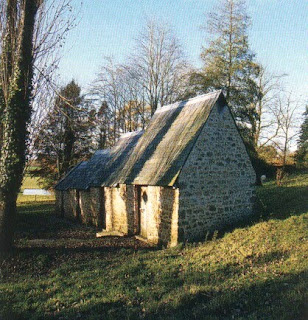
A week ago I mentioned in a post how when reading Geoffrey Beard's Stucco and Decorative Plasterwork in Europe I turned the page to the photo above of the Loggia of the Vila Madama created in Rome in the first quarter of the 16th century. The decoration of this loggia, the Raphael Loggia at the Vatican, and countless other decorative schemes from the 15th century to the 20th were all inspired by the Domus Aurea of Nero then lately discovered.
The Domus Aurea, or Golden House, is known to anyone who studies the decorative arts for it was the discovery of the remnant of this palace under the Baths of Trajan, that gave rise to a renewal of a decorative style of wall decoration that had been forgotten for over a thousand years: a style we know as Grotesque. Grotesque in this sense does not mean ugly but derives from grotta, or cave.
Suetonius, author of On the Lives of the Caesars, wrote a description of the Golden House:
"There was nothing, however, in which Nero was more ruinously prodigal than in building. He made a palace extending all the way from the Palatine to the Esquiline, which at first he called the House of Passage, but but when it was burned shortly after its completion and rebuilt, the Golden House. Its size and splendor will be sufficiently indicated by the following details. Its vestibule was large enough to contain a colossal statue of the emperor a hundred and twenty feet high; and it was so extensive that it had a triple colonnade a mile long. There was a pond too, like a sea, surrounded by buildings to represent cities, besides tracts of country, varied by tilled fields, vineyards, pastures and woods, with great numbers of wild and domestic animals. In the rest of the house all parts were overlaid with gold and adorned with gems and mother-of-pearl. There were dining rooms with fretted ceilings of ivory, whose panels could turn and shower down flowers and were fitted with pipes for sprinkling the guests with perfumes. The main banquet hall was circular and constantly revolved day and night, like the heavens. He had baths supplied with sea water and sulfur water. When the edifice was finished in this style and he dedicated it, he deigned to say nothing more in the way of approval than that he was at last beginning to be housed like a human being."
The Golden House after Nero's death suffered a damnatio memoriae (damnation of memory), was stripped of its marbles and precious materials and the site filled in and built over. In the 15th century it was rediscovered when a young man fell through a cleft into what first thought to be a cave or grotto. Some of what is left of the frescos you see below, faded, fallen away, rotted by damp and algae, but they survive in the form of copies painted on site in the flickering light of candles or oil lamps, and in the inspiration they gave to the artists of the Renaissance and beyond.
Above and below the Raphael Loggia at the Vatican.
The bathroom below, a gift from Pope Leo X to his friend Cardinal Bibbiena, intended to be an authentic reconstruction of a room in an ancient villa, was inspired by the Domus Aurea.
The Senate Appropriations Committee Room in the Capitol, Washington DC.
There's an article in the August issue of World of Interiors about the beautifully painted Erichsen's Mansion in the center of Copenhagen and is described in the text as "one of the finest sequence of Neoclassical interiors in Denmark" and, believe me, it is gorgeous.
Photos:
Stucco and Decorative Plasterwork in Europe
Domus: Wall Painting in the Roman House
The United States Capitol: the Architecture and Decoration
Wikipedia








































%201838%20-%201921%20A%20Quiet%20%20Moment.jpg)


















